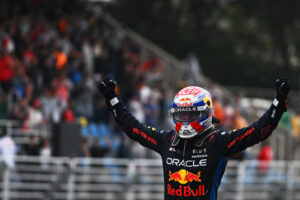Track limits have become an ongoing problem in F1, the never-ending discussion has come up once again.
The calls for consistency surrounding track limits in F1 appeared to have reached a conclusive end with the implementation of Article 33.3 of the Sporting Regulations. The regulation states, ‘Drivers will be judged to have left the track if no part of the car remains in contact with… any white lines defining the track edges’. This seems simple enough, but this year has shown us just how difficult it has become to stay within the white lines. The F1 problem of track limits has no simple solution, so where do we go from here?
What is causing so many track limit infringements?
The cause of these excessive track limit violations largely comes down to two main factors: the track characteristics and the reduced visibility in this new generation of cars.
Track Characteristics
Tracks like the Red Bull Ring have built somewhat of a reputation when it comes to track limits, but this year saw the situation spiral out of control. Race control reviewed over 1,200 potential breaches of the track limits during the race, resulting in 12 post-race penalties for eight of the drivers. Whilst the extremities of the situation appeared to initially center around the Red Bull Ring, we have seen similar scenarios crop up in Qatar, Austin and Mexico.
Although the changes made in Qatar mainly arose from the impact that the curbs had on the tires, the last-minute switch impacted the drivers as we saw 51 infringements in the race. This trend continued into the second US race in Texas, with Verstappen getting his qualifying lap deleted after exceeding the track limits in his final run. In Mexico, during qualifying Alex Albon had his time deleted and missed out on Q3.
If the track limit issue were only to take place at a few tracks a year, this may not be as big of a problem as it has become. However, the races above only highlight the most severe cases that we’ve seen in 2023.
Reduced visibility
Pirelli’s introduction of the new 18-inch wheels has undoubtedly contributed to the reduced visibility that drivers now have from within the cockpit. This runs the risk of the track limit issue carrying over to multiple tracks throughout the year. Drivers have been quick to remark on how difficult it has become to judge the track limits, with Verstappen stating:
“Some of them were so marginal, and when it’s marginal it’s impossible to judge whether it’s out or in and they were still getting deleted.”
Can this be fixed?
This year we have seen the FIA make quick fixes to the tracks by extending and reducing certain track limits, however, these temporary solutions don’t get to the heart of the issue.
Solving this problem has proven to be quite a difficult task for the FIA as each track has its own characteristics that will now allow for a one-size-fits-all rule.
Curbs
Whilst curbs may be the best solution for some tracks, we’ve seen in Qatar how this can also become a drawback that gives rise to its own host of issues. The use of curbs has also been a point of contention in the past due to the dangers that they create on track. The sausage curbs have played a huge part in many collisions over the years leading some to believe that they cause more harm than good.
Gravel/Grass
The idea of replacing runoff areas with gravel or grass has also been a popular suggestion as this would be a foolproof way to ensure that drivers stick within the track limits. Whilst this would be a proven solution, it again cannot be applied to every track where it is required as Formula 1 is not the only category that race at these tracks. The introduction of gravel or grass may not be compatible with the other racing series that use the tracks and will also make the track that much more difficult to maintain.
The white line
The current solution of using the white line looks to be the most consistent and clear marker that we have. Although it has not solved the problem, it allows for no confusion as to what defines the track limits, and it’s difficult to see how Formula 1 will rectify this ongoing problem.






